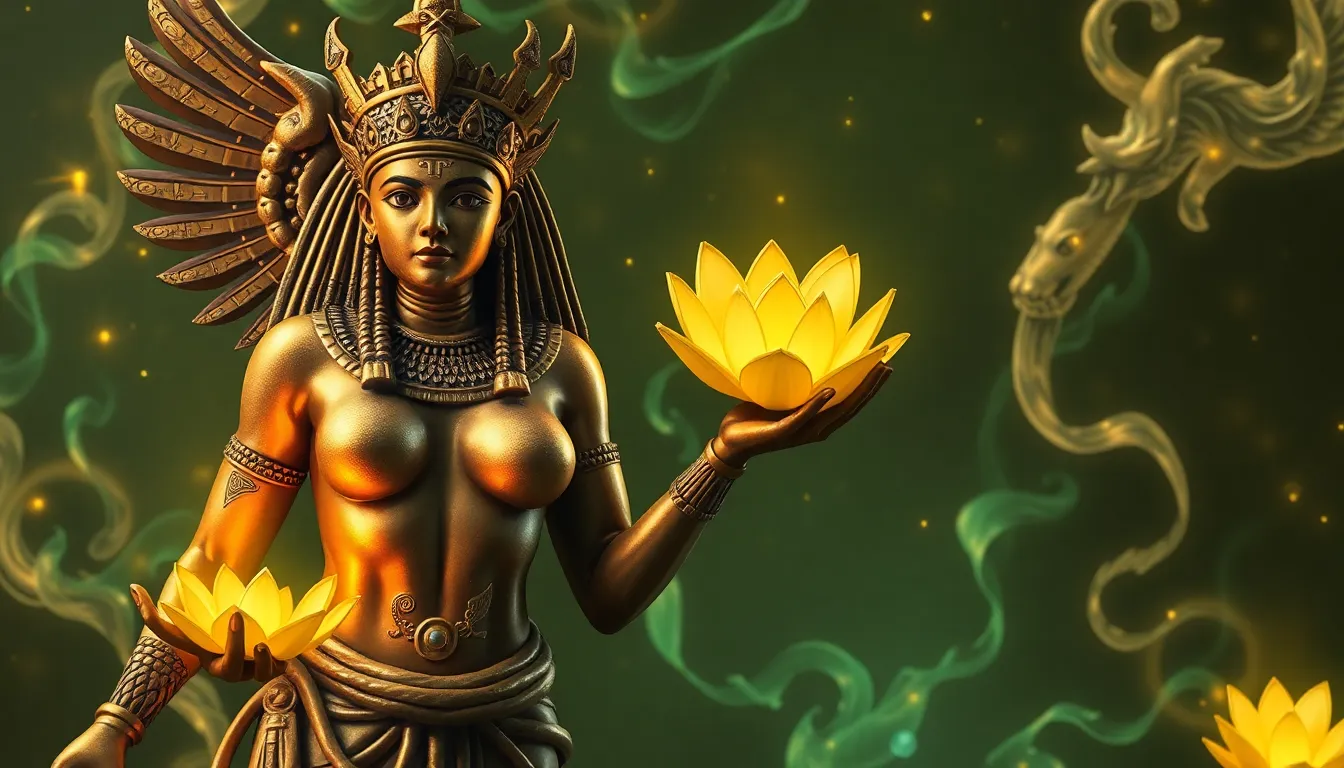The Enchanted Lotus: Myths of Fertility and Rebirth in Ancient Egypt
I. Introduction
The Lotus flower, revered as a sacred symbol in Ancient Egyptian culture, holds profound significance in the realms of fertility and rebirth. This mystical flower, often associated with the life-giving Nile River, embodies the duality of existence—life and death, creation and destruction. Fertility and rebirth are central themes in Ancient Egyptian mythology, reflecting the cyclical nature of life and the importance of renewal.
This article aims to explore the multifaceted symbolism of the Lotus flower, its prominent role in fertility myths, and its connection to the cycle of rebirth in Ancient Egyptian culture. Through examining its cultural significance, artistic representations, and enduring legacy, we can gain a deeper understanding of this enchanting flower’s place in ancient beliefs.
II. The Symbolism of the Lotus Flower
The Lotus flower, particularly the blue and white varieties, is a striking aquatic plant characterized by its beautiful blooms and fragrant petals. It rises from muddy waters, unfolding its delicate flowers in the sunlight. This unique growth pattern serves as a powerful symbol within Ancient Egyptian mythology.
- Purity: The Lotus is often seen as a symbol of purity, representing the idea of rising above the murky waters of life.
- Creation: The flower’s emergence from the mud signifies creation and the potential for new beginnings.
- Cultural Associations: The Lotus is linked to various deities and is frequently depicted in religious contexts.
Throughout Ancient Egyptian culture, the Lotus flower was intimately connected to the divine, often associated with gods and goddesses, particularly in religious and ceremonial practices.
III. The Role of the Lotus in Fertility Myths
The Lotus plays a crucial role in several fertility myths, particularly in the creation myth of Heliopolis. According to this myth, the sun god Ra emerged from a Lotus flower, symbolizing the birth of life and the universe.
Additionally, the Lotus is associated with prominent deities of fertility, such as:
- Isis: The goddess of motherhood and fertility, often depicted as nurturing and protective.
- Hathor: The goddess of love, beauty, and fertility, frequently linked to music and dance.
Rituals and practices involving the Lotus during fertility rites often included offerings of the flower to deities, symbolizing the hope for abundance and the continuation of life.
IV. The Lotus and the Cycle of Rebirth
The emergence of the Lotus from the mud serves as a powerful metaphor for rebirth and renewal. This imagery is closely tied to the Ancient Egyptians’ beliefs about the afterlife and the soul’s journey.
In funerary practices, the Lotus flower was often included in tomb decorations and inscriptions, symbolizing the deceased’s rebirth into the afterlife. Its significance is evident in:
- Funerary Art: Lotus motifs are common in tomb paintings, emphasizing the connection between life, death, and rebirth.
- Tomb Inscriptions: Texts often reference the Lotus as a symbol of resurrection and eternal life.
This connection to the afterlife underscores the belief that death is merely a transition, with the Lotus symbolizing the potential for new life beyond the grave.
V. The Lotus in Ancient Egyptian Art and Literature
The Lotus flower is prevalent in Ancient Egyptian art, appearing in hieroglyphs, sculptures, and decorative motifs. Its graceful form and vibrant colors make it a favored subject among artists.
In literature, references to the Lotus abound in ancient texts and poetry, often celebrating its beauty and symbolic significance. Notable mentions include:
- Hieroglyphs: The Lotus is a common symbol in hieroglyphic writing, representing concepts of creation and purity.
- Poetry: Ancient poets often used the Lotus as a metaphor for love, beauty, and the divine.
The influence of Lotus imagery extended beyond Ancient Egypt, impacting neighboring civilizations and becoming a symbol of spirituality and renewal in later cultures.
VI. The Enchanted Lotus in Rituals and Festivals
The Lotus flower is central to various celebrations and festivals in Ancient Egypt. These events often revolved around the agricultural calendar and the annual flooding of the Nile, which brought fertility to the land.
Key aspects of these celebrations include:
- Lotus Festivals: Annual festivals celebrated the arrival of the Lotus bloom, marking the onset of the planting season.
- Nile Flooding: The inundation of the Nile was seen as a divine blessing, with the Lotus symbolizing the fertility of the land.
Today, modern interpretations of these traditions continue to honor the Lotus’s significance, reflecting its enduring legacy in spiritual and agricultural practices.
VII. Comparative Analysis: The Lotus in Other Cultures
The symbolism of the Lotus flower transcends Ancient Egyptian culture, appearing in various civilizations with both similarities and differences. In many cultures, the Lotus symbolizes purity, enlightenment, and rebirth.
- Hinduism: The Lotus represents spiritual awakening and is associated with deities such as Lakshmi and Brahma.
- Buddhism: In Buddhism, the Lotus symbolizes purity of body, speech, and mind, rising above the muddy waters of attachment and desire.
The impact of Ancient Egyptian beliefs on neighboring civilizations can be seen in the adoption of Lotus imagery in art and religion, showcasing its lasting influence.
VIII. Conclusion
In conclusion, the Lotus flower holds a profound place in Ancient Egyptian mythology as a potent symbol of fertility and rebirth. Its unique characteristics and cultural significance reflect the ancient Egyptians’ deep understanding of life, death, and the cyclical nature of existence.
As we reflect on the relevance of these myths today, the Lotus continues to inspire spiritual and artistic expressions across cultures, inviting further exploration into the rich tapestry of Ancient Egyptian mythology and symbolism.




